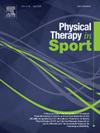运动项目对跟腱病患者小腿肌肉特征的影响。
IF 2.2
3区 医学
Q1 REHABILITATION
引用次数: 0
摘要
目的研究跟腱病变患者。此外,它还探讨了肌肉适应与功能结果之间的关系。设计:前瞻性观察研究。设置:基于实验室的评估。参与者:35名患有跟腱病的参与者完成了为期16周的锻炼计划。主要观察指标:使用ImageJ评估内侧(MG)、外侧腓肠肌(LG)和比目鱼肌(SOL)的EI。在基线和干预后使用b超测量MGCSA、LGCSA和SOL厚度。功能结果包括单腿反动作跳跃(CMJ)、下降CMJ和脚跟上升(HR)耐力测试。结果:症状侧MGEI和LGEI均显著降低(p CSA和LGCSA升高)(p EI和SOL厚度无变化(p >.05)。跟高工作改善(p 2 = 0.11, p > 0.05)。结论:运动计划减少了肌肉EI,增加了肥厚,但没有显著提高小腿耐力。进一步的研究应探讨肌肉适应如何影响跟腱病康复的功能。本文章由计算机程序翻译,如有差异,请以英文原文为准。
Effects of an exercise program on calf muscle characteristics in patients with Achilles tendinopathy
Objective in participants with Achilles tendinopathy. Additionally, it explored the relationships between muscle adaptations and functional outcomes.
Design
Prospective observational study.
Setting
Laboratory-based assessment.
Participants
Thirty-five participants with Achilles tendinopathy completed a 16-week exercise program.
Main outcome measures
Muscle EI of the medial (MG) and lateral gastrocnemius (LG) and soleus (SOL) was assessed using ImageJ. B-mode ultrasound was used to measure MGCSA, LGCSA, and SOL thickness at baseline and post-intervention. Functional outcomes included single-leg countermovement jump (CMJ), drop CMJ, and heel-rise (HR) endurance tests.
Results
MGEI and LGEI significantly decreased on both symptomatic sides (p < 0.05, d = 0.5–0.8). MGCSA and LGCSA increased (p < 0.05, d = 0.3), while SOLEI and SOL thickness did not change (p > 0.05). Heel-rise work improved (p < 0.05, d = 0.4), but jump heights did not. Regression analysis showed that age, BMI, and muscle changes did not predict improvements in HR work (Adjusted R2 = 0.11, p > 0.05).
Conclusions
The exercise program reduced muscle EI and increased hypertrophy but did not significantly improve calf endurance. Further research should explore how muscle adaptations affect function in Achilles tendinopathy rehabilitation.
求助全文
通过发布文献求助,成功后即可免费获取论文全文。
去求助
来源期刊

Physical Therapy in Sport
医学-康复医学
CiteScore
4.50
自引率
8.30%
发文量
125
审稿时长
39 days
期刊介绍:
Physical Therapy in Sport is an international peer-reviewed journal that provides a forum for the publication of research and clinical practice material relevant to the healthcare professions involved in sports and exercise medicine, and rehabilitation. The journal publishes material that is indispensable for day-to-day practice and continuing professional development. Physical Therapy in Sport covers topics dealing with the diagnosis, treatment, and prevention of injuries, as well as more general areas of sports and exercise medicine and related sports science.
The journal publishes original research, case studies, reviews, masterclasses, papers on clinical approaches, and book reviews, as well as occasional reports from conferences. Papers are double-blind peer-reviewed by our international advisory board and other international experts, and submissions from a broad range of disciplines are actively encouraged.
 求助内容:
求助内容: 应助结果提醒方式:
应助结果提醒方式:


